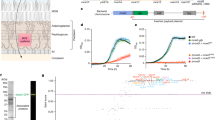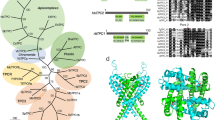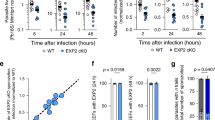Abstract
Mitochondria use transport proteins of the eukaryotic mitochondrial carrier family (MCF) to mediate the exchange of diverse substrates, including ATP, with the host cell cytosol. According to classical endosymbiosis theory, insertion of a host-nuclear-encoded MCF transporter into the protomitochondrion was the key step that allowed the host cell to harvest ATP from the enslaved endosymbiont1. Notably the genome of the microsporidian Encephalitozoon cuniculi has lost all of its genes for MCF proteins2. This raises the question of how the recently discovered microsporidian remnant mitochondrion, called a mitosome, acquires ATP to support protein import and other predicted ATP-dependent activities2,3,4. The E. cuniculi genome does contain four genes for an unrelated type of nucleotide transporter used by plastids and bacterial intracellular parasites, such as Rickettsia and Chlamydia, to import ATP from the cytosol of their eukaryotic host cells5,6,7. The inference is that E. cuniculi also uses these proteins to steal ATP from its eukaryotic host to sustain its lifestyle as an obligate intracellular parasite. Here we show that, consistent with this hypothesis, all four E. cuniculi transporters can transport ATP, and three of them are expressed on the surface of the parasite when it is living inside host cells. The fourth transporter co-locates with mitochondrial Hsp70 to the E. cuniculi mitosome. Thus, uniquely among eukaryotes, the traditional relationship between mitochondrion and host has been subverted in E. cuniculi, by reductive evolution and analogous gene replacement. Instead of the mitosome providing the parasite cytosol with ATP, the parasite cytosol now seems to provide ATP for the organelle.
This is a preview of subscription content, access via your institution
Access options
Subscribe to this journal
Receive 51 print issues and online access
$199.00 per year
only $3.90 per issue
Buy this article
- Purchase on Springer Link
- Instant access to full article PDF
Prices may be subject to local taxes which are calculated during checkout



Similar content being viewed by others
References
John, P. & Whatley, F. R. Paracoccus denitrificans and the evolutionary origin of the mitochondrion. Nature 254, 495–498 (1975)
Katinka, M. D. et al. Genome sequence and gene compaction of the eukaryote parasite Encephalitozoon cuniculi . Nature 414, 450–453 (2001)
Williams, B. A., Hirt, R. P., Lucocq, J. M. & Embley, T. M. A mitochondrial remnant in the microsporidian Trachipleistophora hominis . Nature 418, 865–869 (2002)
Goldberg, A. V. et al. Localization and functionality of microsporidian iron–sulphur cluster assembly proteins. Nature 452, 624–628 (2008)
Winkler, H. H. & Neuhaus, H. E. Non-mitochondrial ATP transport. Trends Biochem. Sci. 24, 64–68 (1999)
Haferkamp, I. et al. A candidate NAD+ transporter in an intracellular bacterial symbiont related to Chlamydiae . Nature 432, 622–625 (2004)
Audia, J. P. & Winkler, H. H. Study of the five Rickettsia prowazekii proteins annotated as ATP/ADP translocases (Tlc): only Tlc1 transports ATP/ADP, while Tlc4 and Tlc5 transport other ribonucleotides. J. Bacteriol. 188, 6261–6268 (2006)
Keeling, P. J. & Fast, N. M. Microsporidia: biology and evolution of highly reduced intracellular parasites. Annu. Rev. Microbiol. 56, 93–116 (2002)
Weidner, E., Findley, A. M., Dolgikh, V. & Skolova, J. in The Microsporidia and Microsporidiosis (eds Wittner, M. & Weiss, L. M.) (American Society of Microbiology, Washington DC, 1999)
Trentmann, O., Decker, C., Winkler, H. H. & Neuhaus, H. E. Charged amino-acid residues in transmembrane domains of the plastidic ATP/ADP transporter from Arabidopsis are important for transport efficiency, substrate specificity, and counter exchange properties. Eur. J. Biochem. 267, 4098–4105 (2000)
Haferkamp, I. et al. Tapping the nucleotide pool of the host: novel nucleotide carrier proteins of Protochlamydia amoebophila . Mol. Microbiol. 60, 1534–1545 (2006)
Pfanner, N. & Geissler, A. Versatility of the mitochondrial protein import machinery. Nature Rev. Mol. Cell Biol. 2, 339–349 (2001)
Vavra, J. “Polar vesicles” of microsporidia are mitochondrial remnants (“mitosomes”)? Folia Parasitol. (Praha) 52, 193–195 (2005)
Zheng, L., Schwartz, C., Magidson, V., Khodjakov, A. & Oliferenko, S. The spindle pole bodies facilitate nuclear envelope division during closed mitosis in fission yeast. PLoS Biol. 5, e170 (2007)
Kunji, E. R. The role and structure of mitochondrial carriers. FEBS Lett. 564, 239–244 (2004)
Mohlmann, T. et al. Occurrence of two plastidic ATP/ADP transporters in Arabidopsis thaliana L.: molecular characterisation and comparative structural analysis of similar ATP/ADP translocators from plastids and Rickettsia prowazekii . Eur. J. Biochem. 252, 353–359 (1998)
Taupin, V., Metenier, G., Vivares, C. P. & Prensier, G. An improved procedure for Percoll gradient separation of sporogonial stages in Encephalitozoon cuniculi (Microsporidia). Parasitol. Res. 99, 708–714 (2006)
de Koning, H. P., Bridges, D. J. & Burchmore, R. J. S. Purine and pyrimidine transport in pathogenic protozoa: from biology to therapy. FEMS Microbiol. Rev. 29, 987–1020 (2005)
Vossbrinck, C. R. & Debrunner-Vossbrinck, B. A. Molecular phylogeny of the Microsporidia: ecological, ultrastructural and taxonomic considerations. Folia Parasitol. (Praha) 52, 131–142 (2005)
Richards, T. A., Hirt, R. P., Williams, B. A. & Embley, T. M. Horizontal gene transfer and the evolution of parasitic protozoa. Protist 154, 17–32 (2003)
Schmitz-Esser, S. et al. ATP/ADP translocases: a common feature of obligate intracellular amoebal symbionts related to Chlamydiae and Rickettsiae. J. Bacteriol. 186, 683–691 (2004)
Didier, E. S. & Weiss, L. M. Microsporidiosis: current status. Curr. Opin. Infect. Dis. 19, 485–492 (2006)
Farthing, M. J. Treatment options for the eradication of intestinal protozoa. Nat. Clin. Pract. Gastroenterol. Hepatol. 3, 436–445 (2006)
Embley, T. M. & Martin, W. Eukaryotic evolution, changes and challenges. Nature 440, 623–630 (2006)
Hollister, W. S., Canning, E. U. & Anderson, C. L. Identification of Microsporidia causing human disease. J. Eukaryot. Microbiol. 43, 104S–105S (1996)
Miroux, B. & Walker, J. E. Over-production of proteins in Escherichia coli: mutant hosts that allow synthesis of some membrane proteins and globular proteins at high levels. J. Mol. Biol. 260, 289–298 (1996)
Acknowledgements
We thank T. Booth for help with confocal microscopy, J. James for help with electron microscopy, I. Haferkamp for providing details about the transport assay for NTTs expressed in E. coli and S. Harris for advice on bioinformatics analyses. A.D.T. was supported by a scholarship from the Division of Biology, Newcastle University. T.M.E. acknowledges support from the British Royal Society and the Leverhulme Trust. E.R.S.K. is supported by the Medical Research Council UK.
Author Contributions A.D.T. cloned the EcNTT1–4 and mtHsp70 genes, generated the antisera and performed the western blots and IFAs; E.R.S.K. and A.D.T. performed the transport assays and their analysis; A.V.G. supervised and contributed to the cloning and antisera generation, western blots and IFAs; J.M.L. performed the electron microscopy work; and R.P.H. and T.M.E. designed the project, supervised the project on a day-to-day basis, and wrote the paper. All authors discussed the results and commented on the manuscript.
Author information
Authors and Affiliations
Corresponding authors
Supplementary information
Supplementary information
The file contains Supplementary Figures S1-S8 with Legends and additional references. (PDF 1426 kb)
Rights and permissions
About this article
Cite this article
Tsaousis, A., Kunji, E., Goldberg, A. et al. A novel route for ATP acquisition by the remnant mitochondria of Encephalitozoon cuniculi. Nature 453, 553–556 (2008). https://doi.org/10.1038/nature06903
Received:
Accepted:
Published:
Issue Date:
DOI: https://doi.org/10.1038/nature06903
This article is cited by
-
Contrasting outcomes of genome reduction in mikrocytids and microsporidians
BMC Biology (2023)
-
Molecular and cellular characterization of four putative nucleotide transporters from the shrimp microsporidian Enterocytozoon hepatopenaei (EHP)
Scientific Reports (2023)
-
Consequences of microsporidian prior exposure for virus infection outcomes and bumble bee host health
Oecologia (2023)
-
Whole-genome sequencing and comparative genomic analysis of a pathogenic Enterocytozoon hepatopenaei strain isolated from Litopenaeus vannamei
Aquaculture International (2023)
-
Combinatorial GxGxE CRISPR screen identifies SLC25A39 in mitochondrial glutathione transport linking iron homeostasis to OXPHOS
Nature Communications (2022)
Comments
By submitting a comment you agree to abide by our Terms and Community Guidelines. If you find something abusive or that does not comply with our terms or guidelines please flag it as inappropriate.



